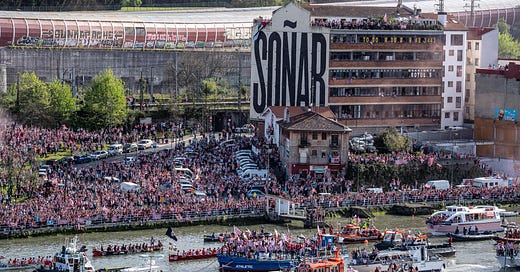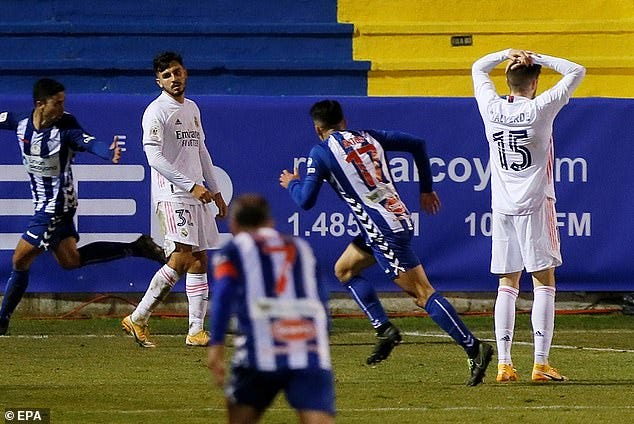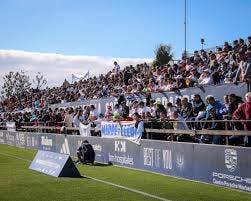Lessons from the Copa del Rey
A change to a historic cup competition has seen some great storylines and shocks but what can other cup competitions learn from the changes?
Since 2019 when the Copa del Rey changed it’s format the competition has sparked into life and given us some great shocks and surprise winners.
The big two of Real Madrid and Barca have won the cup just once each since the format change with it giving smaller sides a better chance of victory.
While many in football are rightly against change and against going against tradition there are plenty of lessons from the change to the Copa del Rey format both good and bad that other national federations could learn from Spain.
In this piece I will look at what positive and negative changes there have been and how things could be improved.
Home advantage
The biggest change to the format of the Copa was to give lower league sides home advantage and to reduce the matches per round from two legged to a single winner takes all.
Previously in the Copa matches were two legged affairs with the lower league side often having little to no chance of winning over two legs. Often the lower ranked side would maybe get ahead in the first leg against a heavily rotated side to then see the first eleven rolled out for the second leg and their hopes evaporate.
In England many are against introducing this change as it takes away the chance for lower league players to get the chance to play at Old Trafford or Anfield.
In Spain while there will be players who now won’t get a chance to play at the Bernabau or Camp Nou it has given home advantage to teams who can welcome sides to grounds they’re not accustomed to playing at.
in 2021 third tier Alcoyano famously knocked Real Madrid out in one of the best examples of the benefits of the new one off format. Real ended up having to bring on Benzema, Kroos and Hazard as they tried to avoid a giant killing but to no avail.
Mirandes were another example of a lower league side who shone with the new format, they knocked out Celta, Sevilla and Villarreal before succumbing to winners Real Sociedad in the semis. They had the perfect blend of hungry players and a coach who wanted to prove themselves on the big stage and an old fashioned stadium in the North of Spain meaning cold nights and an intimate atmosphere to propel them into Spanish football folklore.
As a comparison to how competitive the format has made things in this years round of 64 six lower league sides knocked out higher ranked teams whereas in the FA Cup third round in 23/24 just two sides knocked out higher ranked sides and one of those was Wrexham flying high in league two knocking out league one side Shrewsbury.
This is not to say everything has been perfect about the format change, with the lower league sides unable to cash in the same way if they get a trip to Old Trafford or Anfield clubs have been creative in finding ways to make money out of these matches.
Plenty of temporary stands have popped up in these games but also ticket prices have at times been astronomical. While there was uproar when Tamworth announced they would be charging £42 for a ticket against Tottenham, Deportiva Minera put up prices for their clash against Real Madrid with the cheapest tickets being €80 for the general public and €150 the most expensive.
There is also the major problem of these sides not having grounds of sufficent quality to host their illustrious opponents. While in England we see sides way down the ladder with good quality stadiums the same can’t be said in Spain where they’re often council owned multi purpose stadiums.
Deportiva Minera for instance played Alaves and will host Real Madrid at Cartagonova the home of second tier Cartagena. Minera come from the village of Llano del Beal with a population of just 1,337 and the majority of those who will attend the match will be either Cartagena or Real Madrid fans from the area.
Marbella are another example of a side moving stadiums to monetize their clash. Their usual stadiun of Estadio Municipal de Marbella is being redeveloped and for the past couple of seasons they’ve been playing at essentially a training pitch used by European sides for their winter break.
With their current stadium able to accommodate just 1500 people they sought permission to move their clash up the coast to La Rosaleda which RFEF approved. This has seen them sell over 20,000 tickets but has essentially given up their home advantage.
Less fixture congestion
It’s a hot topic in football right now and rightly so but the change from two legged to one leg ties has quietened down the talk about fixture congestion in Spanish football.
While rotation for midweek fixtures is more common in Spanish football the reducing of the amount of games has been a benefit for Spanish football. The Copa often would be played when two legged midweek and build up fixtures but the change also saw a change in dates with some rounds such as the last 32 being played the first Saturday after the new year. The format also builds up the excitement for the semi finals which see a return to two legged affairs similar to the league cup in England.
No fun for Segunda
While in the first season of the new format Mirandes went on a unbelievable run to get to the semi finals in general the format is weighted heavily against second tier sides who get the worst of both worlds.
Initially they will be the lambs to the slaughter going away to lowly grounds and takin on sides who are pumped up for a giant killing. The first round of this years edition saw six Segunda sides knocked out to lower league sides. The second round saw a further four depart with two going out against sides from the same division. The format can often see Segunda sides end up playing against each other and by the time they’re done only one or two get a mega home draw against one of the big boys.
This seasons round of 32 sees the following clashes involving Segunda sides
Racing Ferrol v Rayo
Granada v Getafe
Huesca v Real Betis
Tenerife v Osasuna
Almeria v Sevilla
Elche v Las Palmas
Cartagena v Leganes
Racing Santander v Celta
Eldense v Valencia
Arguably only Eldense, Almeria and Huesca have vaguely exciting ties there and most will see low crowds and little excitement around their clashes. The fact they often get lower ranked La Liga sides or fellow Segunda sides often sees heavily rotated sides.
In the 23/24 season just one side from Segunda made the final 16 that being Tenerife who were rewarded with a draw at home to Mallorca. It’s hard to see how the format can be tweaked to bring more benefits to Segunda sides but it’s a definite downside of the new format.
Variety of winners
In the five years preceding the format change, Barca had won the Copa four times with Valencia the only other winners. Since the format change the winners list has been Real Sociedad, Barca, Real Betis, Real Madrid and Athletic Club.
No side has dominated the trophy and the removal of the second leg has broken the stranglehold the big clubs with the deeper squads had on the Copa.
Those victories have also brought some of the best moments of Spanish football from the famous Gabarra again taking to the River Nervion after a 40 year wait as Athletic Club celebrated the Copa victory to Joaquin captaining his boyhood club Real Betis to victory at the age of 40.
We saw the best of the Basque clubs in 2020 during the COVID pandemic when both Real Sociedad and Athletic Club gave up the chance of a European spot to try to ensure they got to play a historic final against each other in front of a full crowd of their own fans. Unfortunately they didn’t get that opportunity but we saw the passion of boyhood La Real fan Imanol Alguacil celebrate as Head Coach in his press conference by belting out the clubs anthem.
We’ve seen unfancied sides such as Mallorca and Osasuna make finals and bring large followings for what are seen as historic events for these clubs. Those who make the final also benefit from taking part in the Spanish Super Cup. When changes were made to the Copa they also made changes to the Super Cup, whereas previously it was a curtain raiser between the Copa winners and La Liga winners it’s now the top two La Liga clubs and the two finalists of the Copa in a competition held in Saudi Arabia.
TV Deal
What the RFEF haven’t been able to do successfully is market the Copa del Rey abroad. There is no deal for UK viewers to watch it and in the countries that do have broadcast rights the tv channels can be pretty niche.
There are so many shocks in the Copa and it’s outperformed the FA Cup in terms of shocks and unexpected winners over the last five years and yet outside of Spain it makes very little noise.
This is not a one off the Spanish Segunda is also in a similar place despite it having giants such as Real Zaragoza, Malaga, Depor and Racing Santander in the league. La Liga ended up giving the rights for the second tier to those who already held rights for the top tier and this lack of being able to sell rights abroad is damaging.
Domestically Movistar predominantly hold the rights with 15 matches marked out as free to air. They get very little coverage though with RTVE usually starting their broadcast five minutes before the match and finishing immediately after the match ends. That leaves no time for BBC or ITV style segments that build up the underdog and get you bought into their story.
In my first year living in Spain I was excited to see the Copa del Rey live on free to air and knowing how much build up La Liga games got I was surprised to turn on ONCE half an hour before kick-off and find they were showing a film. As someone so used to the big build up in the UK and seeing the pundits at these small outposts as part of the experience my first taste of the Copa in Spain was disappointing.
This is the case for pretty much all matches with even the trophy presentations having been cut off in previous years so the scheduled film could start on time. This is something RFEF and the broadcasters have to market better to sell the Copa better both domestically and internationally.







